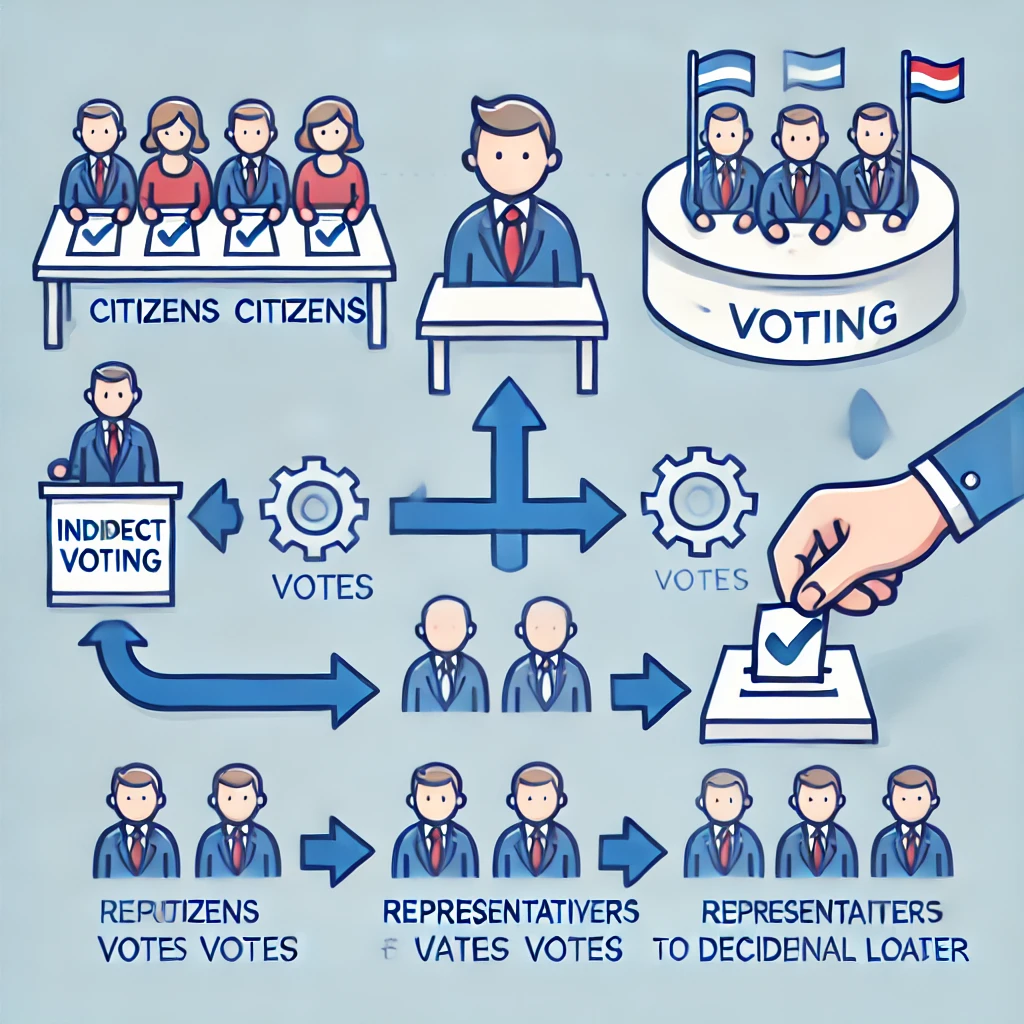Indirect Voting for Dummies: Understanding the Process
Indirect voting for dummies can be a complex concept for many, but this guide simplifies the idea for easy understanding. The system, where citizens do not directly elect a candidate but instead elect representatives who make the final decision, is essential in many democratic and parliamentary structures worldwide. In this article, we’ll break down indirect voting, explain its significance, and explore how it functions in various political systems.
What is Indirect voting for dummies?
Indirect voting is a process in which citizens do not directly vote for the officials they want in power. Instead, they elect representatives who are then responsible for choosing the final officeholders. This form of voting differs from direct voting, where citizens cast their votes directly for the candidate they want to win. Indirect voting is used in various countries, especially in federal and parliamentary democracies.
The most well-known example of indirect voting is the United States Electoral College system. In this case, American voters select electors who then vote for the president and vice president. The idea is to provide a buffer between the population and the office of the presidency. This system ensures that representatives, who are thought to be more informed, make the final decision on leadership.
How Indirect Voting Works: Step by Step
To understand indirect voting, let’s break down the process step by step. First, the general population casts votes in an election to select representatives. These representatives are usually members of a legislative body or a special electoral college. Once elected, the representatives convene to cast votes on behalf of their constituents. The final decision on the candidate or official is made by these representatives, based on the system’s rules and guidelines.
This process can vary widely depending on the country and the specific political system in place. In some cases, the representatives are bound by law or party affiliation to vote a certain way. In other systems, representatives have the discretion to make their own choices. The key idea is that the general public does not have a direct say in the final selection of leaders.
Examples of Indirect Voting Systems Worldwide
Indirect voting systems are not limited to one country; they exist in various forms across the globe. One prominent example is the election of the president of India. The president is chosen by an electoral college, which includes members of both houses of the Indian Parliament and the state legislative assemblies. This system ensures that the president is a consensus candidate supported by a broad section of the country’s political establishment.
Another example is the selection of the upper houses of parliament in several countries. In Germany, members of the Bundesrat, the upper house, are not directly elected by citizens. Instead, they are appointed by the state governments, representing the interests of the federal states. This arrangement ensures that regional interests are considered in national legislation.
The Role of the Electoral College in the United States
The United States Electoral College is one of the most well-known examples of indirect voting. American citizens do not directly elect the president and vice president. Instead, they vote for electors who pledge to support a particular candidate. These electors then cast the official votes for president and vice president, determining the outcome of the election.
Each state has a set number of electors, which is equal to the total number of its senators and representatives in Congress. The total number of electors is 538, and a candidate must secure a majority of 270 electoral votes to win the presidency. The system was designed by the Founding Fathers to balance the influence of populous states with smaller ones.
Advantages of Indirect voting
Indirect voting has several advantages that make it a viable option in certain political systems. One major advantage is that it provides a buffer between the general population and the final selection of leaders. This buffer allows for more informed and deliberate decision-making by elected representatives who may have a better understanding of political nuances.
Additionally, indirect voting can help prevent the tyranny of the majority. By having representatives make the final decision, minority interests are more likely to be considered. This system encourages consensus-building and compromise, which can lead to more stable governance. Furthermore, indirect voting can make the electoral process more manageable in large and diverse countries.
Criticisms and Controversies Surrounding Indirect Voting
One of the main criticisms is that it can undermine the principle of one person, one vote. Critics argue that this system can give disproportionate power to smaller or less populous regions. In the United States, for example, the Electoral College has been criticized for allowing a candidate to win the presidency without winning the popular vote.
Another issue is the potential for representatives to act against the wishes of their constituents. In some systems, representatives are not legally bound to follow the popular vote, which can lead to accusations of undemocratic practices. The lack of transparency in the decision-making process can also be a point of concern for voters who feel disconnected from the final outcome.
Comparing Direct and Indirect Voting Systems
Understanding the differences between direct and indirect voting is crucial for evaluating the effectiveness of each system. Direct voting is straightforward: citizens cast their votes for a candidate, and the candidate with the most votes wins. This method is commonly used in elections for local government officials, legislators, and referendums.
Indirect voting, on the other hand, involves multiple layers of decision-making. While this can lead to more informed choices, it can also create confusion and a sense of disenfranchisement among voters. Both systems have their merits and drawbacks, and the choice between them often depends on the country’s historical, cultural, and political context.
See Also: Deora Hair Salon and Spa Brampton: Escape to Style and Relaxation
The Impact of Indirect Voting on Democracy
The impact of Indirect voting for dummies on democracy is a topic of considerable debate among political scientists and experts. Proponents argue that it can enhance democratic governance by ensuring that leaders are chosen through a thoughtful and deliberative process. By giving representatives a role in the selection, indirect voting can promote balanced decision-making and protect minority interests.
However, critics contend that indirect voting can weaken democratic accountability. When voters do not have a direct say in electing leaders, it can reduce trust in the electoral process. The potential for discrepancies between the popular vote and the final outcome can also erode confidence in democratic institutions. The debate over the effectiveness of indirect voting continues to shape discussions about electoral reform.
Case Study: The 2016 United States Presidential Election
The 2016 United States presidential election is a notable example of the controversies surrounding indirect voting. Donald Trump won the presidency despite losing the popular vote to Hillary Clinton by nearly three million votes. This outcome reignited debates about the fairness and relevance of the Electoral College system.
Supporters of the Electoral College argued that it ensures representation for smaller states and prevents regional imbalances. Critics, however, claimed that the system undermines democratic principles by allowing a candidate to win without majority public support. The 2016 election highlighted the complexities and challenges of maintaining an Indirect voting for dummies system in a modern democracy.
Reforms and Proposals for Improving Indirect Voting
Over the years, there have been various proposals to reform or abolish indirect voting systems like the Electoral College. Some suggest adopting a national popular vote to ensure that the candidate with the most votes always wins. Others advocate for proportional representation, where electoral votes are distributed based on the percentage of the popular vote.
In India, there have been discussions about making the presidential election process more transparent and democratic. Similar debates have occurred in other countries that use indirect voting systems. The challenge lies in finding a balance between fair representation and practical governance. Any changes to these systems would require careful consideration of their potential impact.
Conclusion: Understanding Context
Indirect voting for dummies is a complex but important aspect of many democratic systems around the world. It offers both benefits and challenges, balancing the need for informed decision-making with the principles of democratic representation. By understanding how indirect voting works, citizens can better appreciate the strengths and weaknesses of their electoral systems.
While the debate over indirect voting will likely continue, it remains a critical feature of governance in many countries. Whether through the Electoral College in the United States or electoral colleges in parliamentary democracies, this system has shaped the course of history. Understanding its intricacies helps us engage more thoughtfully in discussions about democracy and electoral reform.






